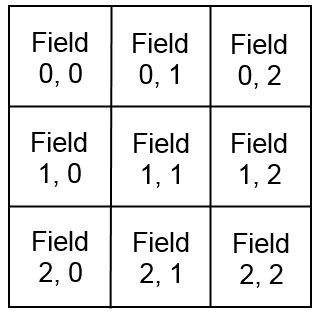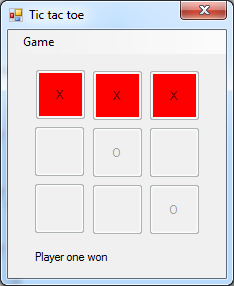Introduction
I am a big fan of unit testing. Although there are many books and online resources
about it, I always have had a hard time finding a simple yet complete solution example with unit tests.
This small project is my contribution to the goal to make such projects more present on the web.
Background
Tic tac toe is a simple game. It's a common first project for student game developers. If you don't know the rules, here is
the official Wikipedia page: http://en.wikipedia.org/wiki/Tic-tac-toe.
Using the code
The solution has three projects - TicTacToeLib is the main project and it contains all
the game logic, TicTacToeLibTests is the test project,
and TicTacToe is a Windows Forms project to display the game, but it can easily be replaced by any other GUI project type (WPF, Web, etc).
Two classes handle
the game logic - Board and Field.
Board is a container of Fields.

The Field class' only purpose is to keep information about its status. It can be
EMPTY, which is the default value, or PLAYER1/PLAYER2.
Whenever status is changed, the FieldStatusChanged event is fired.
public class Field
{
private FIELD_STATUS _fieldStatus;
public event EventHandler FieldStatusChanged;
public FIELD_STATUS FieldStatus
{
get
{
return _fieldStatus;
}
set
{
if (value != _fieldStatus)
{
_fieldStatus = value;
OnFieldStatusChanged();
}
}
The Board class listens to FieldStatusChanged events from its
Fields collection and checks for end game conditions. Event handlers are created after fields for each field in
the Board class.
private void AddFieldEventListeners()
{
for (int i = 0; i < _fields.GetLength(0); i++)
{
for (int j = 0; j < _fields.GetLength(1); j++)
{
_fields[i, j].FieldStatusChanged += Board_FieldStatusChanged;
}
}
}
From game rules we can define five end game conditions:
Whenever status in any field changes, the CheckWinCondition method is invoked in
the Board class. If any win condition or tie is applicable, board fires
the GameEnd event. As a parameter,
event sends the GameStatus class which is a simple two enum collection with information about
the winning player and the win condition.
The caller should handle it appropriately - in this example, the Windows Form disables all controls used to display fields, displays
the game result, and highlights the winning row, column, or diagonal.
And finally testing. Since classes Field and GameStatus are simple, only
the Board class is covered with tests.
There are nine tests in the BoardTests class. First three check if
the Board class throws exceptions with a bad constructor parameter.
[TestMethod]
[ExpectedException(typeof(ArgumentNullException))]
public void TestConstructorFieldNull()
{
Board board = new Board(null);
}
[TestMethod]
[ExpectedException(typeof(ArgumentException))]
public void TestConstructorFieldNotSquareMatrix()
{
Field[,] fields = new Field[2, 3];
fields[0, 0] = new Field();
fields[0, 1] = new Field();
fields[0, 2] = new Field();
fields[1, 0] = new Field();
fields[1, 1] = new Field();
fields[1, 2] = new Field();
Board board = new Board(fields);
}
[TestMethod]
[ExpectedException(typeof(ArgumentNullException))]
public void TestConstructorNullFieldsInMatrix()
{
Field[,] fields = new Field[3, 3];
fields[0, 0] = new Field();
fields[0, 1] = new Field();
fields[0, 2] = new Field();
fields[1, 0] = new Field();
fields[1, 1] = null;
fields[1, 2] = new Field();
fields[2, 0] = new Field();
fields[2, 1] = new Field();
fields[2, 2] = new Field();
Board board = new Board(fields);
} The forth test tests if the Fields collection is successfully set as
the class Fields property.
[TestMethod]
public void TestConstructorRegularCase()
{
Field[,] fields = new Field[3, 3];
fields[0, 0] = new Field();
fields[0, 1] = new Field();
fields[0, 2] = new Field();
fields[1, 0] = new Field();
fields[1, 1] = new Field();
fields[1, 2] = new Field();
fields[2, 0] = new Field();
fields[2, 1] = new Field();
fields[2, 2] = new Field();
Board board = new Board(fields);
Assert.AreEqual(fields.GetLength(0), board.Fields.GetLength(0));
Assert.AreEqual(fields.GetLength(1), board.Fields.GetLength(1));
} The last five tests simulate and test win conditions. All tests have three parts, first
the Board object construction:
[TestMethod]
public void TestAllFieldsInRowWinCondition()
{
Field[,] fields = new Field[3, 3];
fields[0, 0] = new Field() { FieldStatus = FIELD_STATUS.EMPTY };
fields[0, 1] = new Field() { FieldStatus = FIELD_STATUS.EMPTY };
fields[0, 2] = new Field() { FieldStatus = FIELD_STATUS.EMPTY };
fields[1, 0] = new Field() { FieldStatus = FIELD_STATUS.EMPTY };
fields[1, 1] = new Field() { FieldStatus = FIELD_STATUS.EMPTY };
fields[1, 2] = new Field() { FieldStatus = FIELD_STATUS.EMPTY };
fields[2, 0] = new Field() { FieldStatus = FIELD_STATUS.EMPTY };
fields[2, 1] = new Field() { FieldStatus = FIELD_STATUS.EMPTY };
fields[2, 2] = new Field() { FieldStatus = FIELD_STATUS.EMPTY };
Board board = new Board(fields);
Second, the event handler is created for the Board GameEnd event. When
the event is fired, it will assert if the board returned the correct win parameters:
board.GameEnd += (sender, e) =>
{
Assert.AreEqual(GAME_STATUS.PLAYER_ONE_WON, e.GameProgress);
Assert.AreEqual(WIN_CONDITION.ROW, e.WinCondition);
Assert.AreEqual(0, e.WinRowOrColumn);
};
Third, the game is simulated by changing the board field status:
fields[0, 0].FieldStatus = FIELD_STATUS.PLAYER1;
fields[1, 1].FieldStatus = FIELD_STATUS.PLAYER2;
fields[0, 1].FieldStatus = FIELD_STATUS.PLAYER1;
fields[2, 2].FieldStatus = FIELD_STATUS.PLAYER2;
fields[0, 2].FieldStatus = FIELD_STATUS.PLAYER1;
In this test, all fields in row 0 belong to player 1 (X) and the GameEnd event is fired. Asserts verify player one as winner, row as win condition, and row 0 as winning row.
If this game is simulated in the article solution, the Windows Form would handle it in
the following way:

Since
the remaining tests have the same structure, they are not described here.
Points of interest
Libraries covered with tests make maintaining easier. They give great confidence in code and possible code changes.
For further study, I encourage the reader to make more test cases and another GUI project that will use TicTacToeLib.
History
 General
General  News
News  Suggestion
Suggestion  Question
Question  Bug
Bug  Answer
Answer  Joke
Joke  Praise
Praise  Rant
Rant  Admin
Admin 






